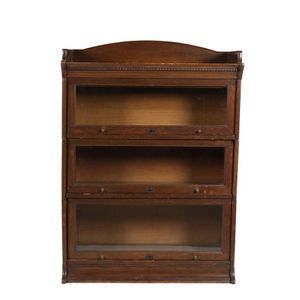Four-tier Oak Bookcase with Leadlight Doors and Drawer
You must be a subscriber, and be logged in to view price and dealer details.
Subscribe Now to view actual auction price for this item
When you subscribe, you have the option of setting the currency in which to display prices to $Au, $US, $NZ or Stg.
- Fluting - A form of decoration found on many pieces of furniture, as well as ceramics, silver and clocks, in which round-bottomed grooves, of varying width and depth, are let into columns, pilasters, legs. As a general rule, flutes are cut in the vertical, though they may follow a turned leg in a spiral pattern. In cross-section, they may be described as a series of 'U' shapes, rising and narrowing at each end of the groove. Fluting is the opposite of reeding, with which fluting is often associated.
- Tier - One or more under-shelves of a table or cabinet.
- Cornice - The upper section of a high piece of furniture such as a bookcase, wardrobe or cabinet that sits immediately on the main structure. The cornice is usually decorated with a variety of architectural mouldings, worked either with a moulding plane or, from the later 19th century, by machine. The front and side of the cornice are mitred together, strengthened by glue blocks, and the back is generally a simple dovetailed rail to hold the structure together. Cornices are generally, though not always, fitted separately to the piece and are held in place either by screws sunk into the top board or by wooden corner blocks. A pediment may sit above the cornice, but sometimes the terms cornice and pediment are used interchangeably.
- Oak - Native to Europe and England, oak has been used for joinery, furniture and building since the beginning of the medieval civilisation. It is a pale yellow in colour when freshly cut and darkens with age to a mid brown colour.
Oak as a furniture timber was superceded by walnut in the 17th century, and in the 18th century by mahogany,
Semi-fossilised bog oak is black in colour, and is found in peat bogs where the trees have fallen and been preserved from decay by the bog. It is used for jewellery and small carved trinkets.
Pollard oak is taken from an oak that has been regularly pollarded, that is the upper branches have been removed at the top of the trunk, result that new branches would appear, and over time the top would become ball-like. . When harvested and sawn, the timber displays a continuous surface of knotty circles. The timber was scarce and expensive and was used in more expensive pieces of furniture in the Regency and Victorian periods. - Acanthus - A stylized leaf motif, one of the primary decorative elements of classical Greek and Roman architecture, derived from the genus of flowering plants in the family Acanthaceae, native to tropical and subtropical regions of the Mediterranean area. It is a common element in classical Greek and Roman design, and is often seen in Corinthian and Composite order columns and used as a decorative element in English, European and Australian furniture, particularly on the curve of a leg, and as decoration for a corbel.
- Leadlighting - The use of stained glass, held together with leaded strips, sometimes found in cabinet furniture. While stained glass is not uncommon in Victorian houses, it is unusual to find it in furniture before the end of the 19th century. It was favoured by cabinetmakers for sideboards and smaller pieces such as dinner trolleys, in the style of the Art Nouveau, and is often found in kitchen cabinets and display cabinets dating from the 1930s and 1940s.
This item has been included into following indexes:
Visually similar items

Modular bookcase, by G Smerdon and Sons, early 20th century oak, three part, Globe Wernicke style, height 123 cm, length 89 cm, depth 36 cm

Bookcase dresser, 19th century in cedar & mahogany (restoration required). Height 206 cm, width 127 cm, depth 44 cm

A small glazed blackwood and huon pine inlaid display cabinet, the castle top pediment above a single glazed door, raised on a block feet 38 cm wide, 15 cm deep, 51 cm high

A Regency mahogany side cabinet with a verde marble top, above two doors with brass grills and silk curtains, fluted feet, 90 x 91 x 35 cm
